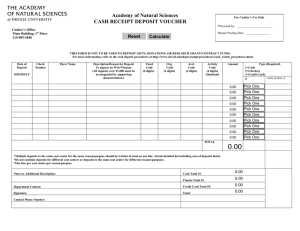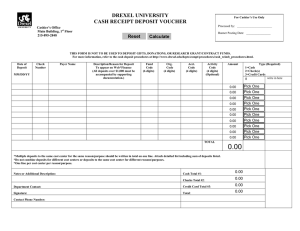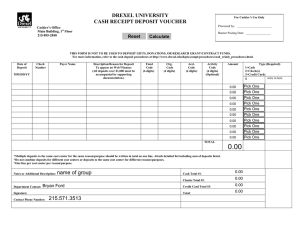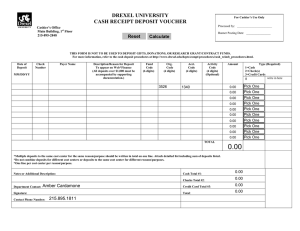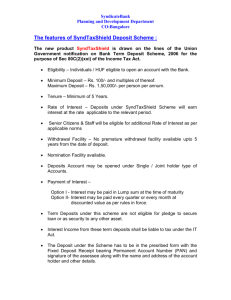AN A N A L Y T I C ... D E P O S I T I...
advertisement
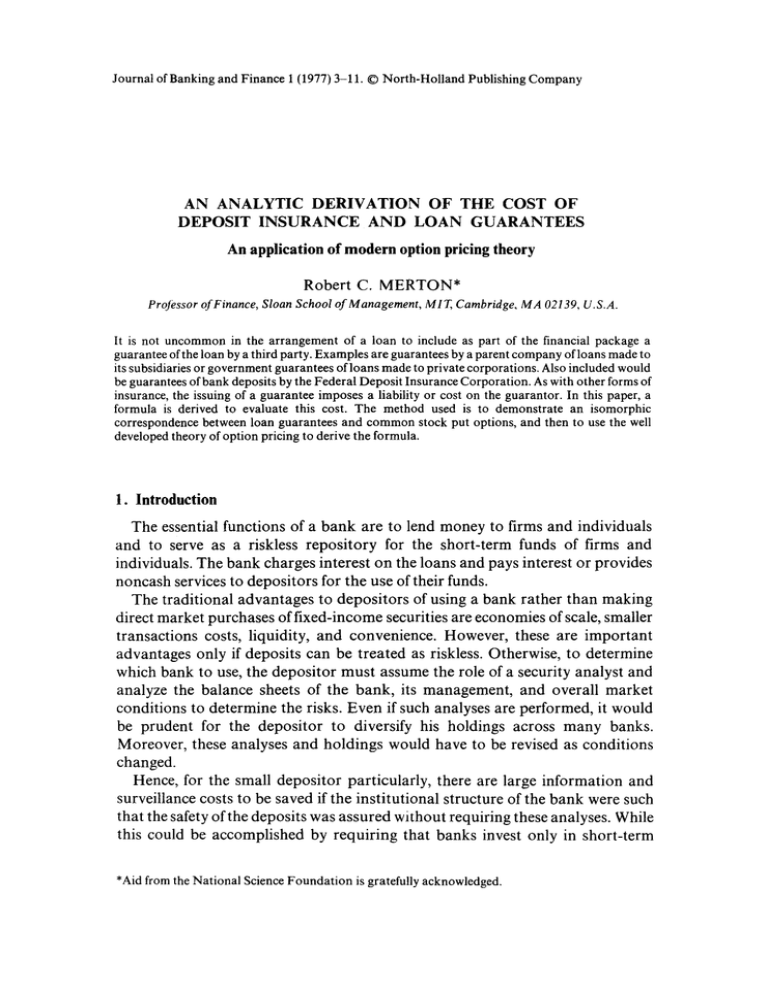
Journal of Banking and Finance 1 (1977) 3-11. © North-Holland Publishing Company
AN ANALYTIC D E R I V A T I O N O F THE COST O F
DEPOSIT INSURANCE AND LOAN GUARANTEES
An application of modern option pricing theory
Robert C. MERTON*
ProJessor of Finance, Sloan School of Management, M I T, Cambridge, M A 02139, U.S.A.
It is not uncommon in the arrangement of a loan to include as part of the financial package a
guarantee of the loan by a third party. Examples are guarantees by a parent company of loans made to
its subsidiaries or government guarantees of loans made to private corporations. Also included would
be guarantees of bank deposits by the Federal Deposit Insurance Corporation. As with other forms of
insurance, the issuing of a guarantee imposes a liability or cost on the guarantor. In this paper, a
formula is derived to evaluate this cost. The method used is to demonstrate an isomorphic
correspondence between loan guarantees and common stock put options, and then to use the well
developed theory of option pricing to derive the formula.
1. Introduction
The essential functions of a bank are to lend money to firms and individuals
and to serve as a riskless repository for the short-term funds of firms and
individuals. The bank charges interest on the loans and pays interest or provides
noncash services to depositors for the use of their funds.
The traditional advantages to depositors of using a bank rather than making
direct market purchases of fixed-income securities are economies of scale, smaller
transactions costs, liquidity, and convenience. However, these are important
advantages only if deposits can be treated as riskless. Otherwise, to determine
which bank to use, the depositor must assume the role of a security analyst and
analyze the balance sheets of the bank, its management, and overall market
conditions to determine the risks. Even if such analyses are performed, it would
be prudent for the depositor to diversify his holdings across many banks.
Moreover, these analyses and holdings would have to be revised as conditions
changed.
Hence, for the small depositor particularly, there are large information and
surveillance costs to be saved if the institutional structure of the bank were such
that the safety of the deposits was assured without requiring these analyses. While
this could be accomplished by requiring that banks invest only in short-term
*Aid from the National Science Foundation is gratefully acknowledged.
4
R.C. Merton, The cost of deposit insurance and loan guarantees
government securities, such a requirement would not allow banks to perform
their otlaer function, which is to lend money to firms and individuals. Moreover,
such a restriction would require surveillance to ensure compliance. While such
surveillance could be carried out in a centralized fashion (e.g. by a government
regulatory agency), the financial burden from noncompliance would still be
borne by the depositor.
A sensible alternative choice would be to have third-party guarantees where
the capability and willingness of that party to meet its obligations are beyond
question. For the scale of the banking system, this almost certainly means that the
third-party would be the government or one of its agencies. While these
guarantees could take the form of guarantees on the loans made by banks, a less
expensive and more efficient alternative form is to guarantee the deposits. Indeed,
one observes widespread use of such deposit guarantees although their
institutional forms differ. In the United States, there is the separately-funded
Federal Deposit Insurance Corporation (FDIC) for commercial banks and the
Federal Savings and Loan Insurance Corporation for savings and loan
associations. In other countries the government may own the banks or there may
simply be a widespread belief that the government will act to, in effect, guarantee
deposits. Indeed, it is probably fair to say that although the FDIC is separately
funded, there is a further belief that the U.S. government would take the necessary
actions to protect depositors in the event of a major default by banks that
bankrupted the FDIC. To the extent such implicit guarantees are politically
binding, they impose a cost on the guarantor which is essentially the same as for
explicit guarantees.
In this paper, a systematic theory for determining these costs is presented. As
will be shown, techniques for solving this problem can be found in the seemingly
unrelated area of Finance called Option Pricing theory. Indeed, the properties of
deposit insurance viewed as a security are isomorphic to those of a put option. 1
This is fortunate because recent research has led to a major 'breakthrough' in the
development of an option pricing theory.
In a seminal paper, Black and Scholes (1973) developed an explicit formula for
pricing call options 2 on common stocks. While there had been a number of earlier
efforts dating back at least to 1900, the Black-Scholes analysis is a major
advancement for two reasons. First, the important assumptions required to
derive the formula are substantially weaker than in the earlier efforts. Second, the
inputs required by the formula are either directly observable variables or ones
1The essential terms of the contract are defined later in the paper. For further discussion of pu t
options, see Black and Scholes (1973), Merton (1973a, b), Brennan and Schwatrz (1977), and
Parkinson (1977).
2A call option gives its owner the right to buy a specified number of shares of a given stock at a
specified price per share on or before a specified date. For an alternative derivation of the BlackScholes model, see Merton (1973a). Smith (1976) provides an excellent survey article of the research
on option pricing theory.
R.C. Merton, The cost of deposit insurance and loan guarantees
5
that can be readily estimated. Hence, the formula can be empirically tested, and if
proved satisfactory, it can then be used as a practical tool.
Such tests have been made in at least two studies with generally favorable
outcomes. 3 Moreover, the Black-Scholes formula is probably the analytical tool
most widely used by investors and market makers in the rapidly growing
organized option exchange markets.
While call options are a very specialized type of financial instrument, it is
straightforward to see that the Black-Scholes techniques can be applied to the
pricing of corporate liabilities in general. Hence their original analysis has led to a
unified theory for the pricing of virtually any financial claim on the firm. 4
Further, because the formulas derived do not require a history of market prices
for the type of security being evaluated, it shows great promise as an appraisal
tool for evaluating nontradeable securities, such as insurance contracts, which is
the substantive subject of this paper. 5
2. A model for pricing deposit insurance
As discussed in the introduction, the development of the deposit-insurance
pricing model has as its foundation the isomorphic relationship between deposit
insurance and common stock put options. Hence, before developing the model, I
make a brief digression to summarize the relevant findings in option pricing
theory.
The essential terms of a 'European' 6 put option on a common stock are that its
owner has the right to sell a specified number of shares of a given stock at a
specified price per s h a r e - the 'exercise price' - on a specified d a t e - the 'expiration
date'. A put option purchase is different from the sale of a futures contract because
the put owner has a choice whether or not to 'exercise his option' to sell at the
specified price. Indeed, if this option is not exercised on the expiration date, the
contract expires and is worthless. Hence, if on the expiration date the stock price
per share, S, is higher than the exercise price per share, E, the put owner would
clearly not exercise his right to sell the stock at the exercise price when he could
sell it on the open market at a higher price. In this case, the owner would allow the
put to expire worthless. However, if on the expiration date the stock price was
lower than the exercise price, then the put owner would exercise his right, and the
value of the put option would be the difference between the exercise price and the
stock price, ( E - S), times the number of shares specified in the put contract.
3See Black and Scholes (1972) and Galai (1975).
~See Merton (19741 and Smith (19761.
5Brennan and Schwartz (1976) have used a similar model to evaluate the cost of certain insurance
company guarantees of equity-based life insurance plans.
°The term 'European' is applied to options that can only be exercised on the expiration date. An
'American' type option can be exercised on or before the expiration date.
6
R.C. Merton, The cost of deposit insurance and loan guarantees
Thus, the value of a put on one share of stock at the expiration date can be
written as
P(0) = Max [ 0 , E - S],
(1)
where P ( T ) is the price of a put with length of time T to go before expiration.
Since the value of the put at expiration depends on the stock price, its value
prior to expiration will depend on the probability distribution for the range of
stock prices on the expiration date.
Using the standard 'frictionless' market assumptions and the additional
assumption that the stochastic process generating the stock's returns can be
described by a diffusion process with a constant variance per unit time, 7 Black
and Scholes impose the condition of 'no arbitrage opportunities' to derive a
formula for the value of a put option. The formula can be written as
P ( T ) = E e- r Tq~(y2 )-- Scp(y I ),
(2)
where:
Y2 = Yl + a ~ / T ,
(it'( • )is the cumulative normal density function, S is the current price per share for
the stock, r is the market rate of interest per unit time on riskless securities, and a 2
is the variance rate per unit time for the (logarithmic) rate of the return on the
stock. While eq. (2) may appear formidable, it only requires as inputs the interest
rate, the exercise price, the current stock price, the length of time until expiration,
and the variance rate. Of these, only the variance rate on the stock is not directly
observable, and it can be reasonably estimated. Note, more importantly, that
neither the expected return on the stock nor investors' preferences are required as
inputs. Hence the formula is robust with respect to both these nonobservable
variables. This completes the digression.
With this as background, consider the following simple model of a firm that
borrows money by issuing a single homogeneous debt issue. The terms of the debt
are that the firm promises to pay a total of B dollars on a specified date (the
'maturity' date) and in the event that the promised payment is not made, the firm
defaults to the bondholders all the assets of the firm. There are no interim or
7The model can be derived in various modified forms to allow for relaxation of most of the
'frictionless' market assumptions. Also, the constant variance rate assumption is not necessary. See
Smith (1976) for a discussion of these modifications. For expositional convenience, the original
Black-Scholes assumptions are retained throughout the paper.
R.C. Merton, The cost of deposit insurance and loan guarantees
7
coupon payments required on the debt, and so the debt is a term discount issue.
On the maturity date, if the value of the firm's assets, V, is larger than the
promised payment on the bond issue, B, then it is in the interests of the equity
holders for the management to make the payment (by selling assets if necessary).
Hence, the value of the debt issue at this point will be B, and the value of equity
will be V - B . However, if on the maturity date the value of the firm's assets is less
than the promised payment, then the management will be unable to make the
payment even by selling assets. Hence, the firm is defaulted to the bondholders
and the value of the debt issue will be V. The value of the equity will be zero.
In an abbreviated form, at the maturity date, the value of the debt can be
written as Min IV, B] and the value of the equity a~ Max [0, V-B]. As long as
there is a positive probability that the value of the assets on the maturity date can
be less than the promised payment, then there is a positive probability of
bankruptcy, and the debt is risky. In another paper [Merton (1974)], I have
analyzed the evaluation of such risky debt along Black-Scholes lines.
Consider the impact of a third-party guarantee of the payment to the
bondholders where there is no uncertainty about the obligations of the guarantee
being met. The terms of the guarantee are that in the event the management does
not make the promised payment to the bondholders, the guarantor will meet
these payments. However, if such an event occurs, the firm will default its assets to
the guarantor. In effect, the guarantor has ensured that the value of the firm's
assets on the maturity date will be at least B dollars. Like a traditional insurance
policy, the guarantee has value to the insured and imposes a cost on the insurer.
Hence, the firm would normally be expected to pay for the guarantee an amount
at least equal to its actuarial cost.
To determine this cost, I begin by reexamining the payoffs to the various claims
on the maturity date. If the value of the firm's assets exceed the promised
payment, then, as without the guarantee, the bondholders receive B and the
equityholders receive V - B . However, now if the value of the assets is less than
the promised payment, then the bondholders receive B, the equityholders receive
nothing, and the third-party guarantor has a net payout or loss of ( B - V), the
discrepancy between the promise payment and the value of assets.
In an abbreviated form, at the maturity date, the value of equity is the same
with or without the guarantee, Max [0, V - B]; the value of the debt is always B
and therefore riskless; and the value of the guarantor's 'claim' is Min [0, V - B]
which is nonpositive. In effect, the result of the guarantee is to create an additional
cash inflow to the firm o f - Min [0, V - B] dollars. But, - Min [0, V - B] can be
rewritten as Max [0, B - V]. Hence, if G(T) is the value to the firm of the
guarantee when the length of time until the maturity date of the bond is T, then
G(O) = Max [ 0 , B - V].
(3)
By comparing eq. (3) with eq. (1), we see that the payoff structure of the loan
8
R.C. Merton, The cost of deposit insurance and loan guarantees
guarantee is identical to that of a put option, where in (3) the promised payment,
B, corresponds to the exercise price, E, and the value of the firm's assets, V,
corresponds to the common stock's price, S. Essentially, by guaranteeing the debt
issue, the guarantor has issued a put option on the assets of the firm which gives
management the right to sell those assets for B dollars on the maturity date of the
debt.
Hence, using the identical arguments used by Black and Scholes to derive the
value of a put option written in eq. (2), we can derive a formula for the value of the
guarantee, and it can be written as
G(T )= Be-'rep(x2 ) - Vq)(x~ ),
(4)
where:
X1 -----{log( B / V ) - ( r - t - f f - ~ ) T } / a N / T ,
X 2 ~-~X1 +ax//T,
V is the current value of the assets of the firm, and a 2 is now the variance rate per
unit time for the logarithmic changes in the value of the assets.
Eq. (4) can be used to evaluate the cost to the guarantor of guaranteeing a
discount debt issue with a face value of B dollars and maturity T.
Let B e x p [ - R ( T ) T ] be the market value of the debt when there is no
guarantee, where R (T) is the promised yield. Clearly, the market value of the debt
with a guarantee is B exp [ - rT], and therefore,
G(T) + B exp [ - R(T)T] = B exp [ - rT],
or
G(T)
B e - r ~ - 1 - e-[R(T)- r]T.
(4')
Eq. (4') gives the cost of the loan guarantee as a fraction of the amount of money
raised. I have [Merton (1974, p. 457)] computed values of [R(T) - r] for a variety
of maturity dates, variance rates, and firm values. Inspection of these values will
demonstrate that the cost of loan guarantees can be substantial.
Now, suppose that the firm is a bank and the debt issue corresponds to
deposits. Because most deposits are of the demand type, the model assumption of
a term-debt issue is not strictly applicable. However, if one reinterprets the length
of time until maturity as the length of time until the next audit of the bank's assets,
then from the point of view of the guarantor, the model's structure is reasonable
R.C. Merton, The cost of deposit insurance and loan guarantees
9
even for demand deposits. Therefore, from the point of view of the guarantor,
deposits can be treated as if they were term and interest bearing.
For deposit insurance where both principal and interest are guaranteed, the
insured deposits will be riskless and their current value can be written as
D = B e -~r
(5)
If g is the cost of the guarantee per dollar of insured deposits, i.e. G(T)/D, then
from (4) the formula for g can be written as a function of two variables:
g(d, x)= e(h2
(hi),
(6)
where:
h 2 ---ha + x / z ,
d - D/V
is the current deposit-to-asset value ratio, and x - o-z T is the variance of
the logarithmic change in the value of the assets during the term of the deposits.
Hence, as long as the deposit-to-asset value ratio and the volatility of the
underlying assets remain fixed, the cost of deposit insurance per dollar of deposits
is constant. As one would expect, the change in the cost with respect to an increase
in the deposit-to-asset value ratio is positive, and is given by
8g
•
-~d=q)(hl )/d 2.
The change in the cost with respect to an increase in x is also positive, and is given
by
~zz =q)' (ha )/ (2dx//x ),
where the prime denotes the first derivatives. Hence, an increase in either the
variance rate of the assets or the length of time that the insurance is in force will
increase the cost per dollar of deposits.
F r o m eq. (6), we have that changes in the market rate of interest will have no
effect on the cost of deposit insurance unless such changes affect the deposit-toasset value ratio. To develop some sense of the magnitudes implied by eq. (6),
table 1 displays the cost per dollar of deposits for different values of d and r. It is
10
R.C. Merton, The cost of deposit insurance and loan guarantees
Table 1
Cost of deposit insurance per dollar of insured deposits.
Cost of
deposit insurance ($)
Deposit-to-asset
value ratio
0.00055
0.00040
0.00028
0.00018
0.00011
0.85
0.85
0.85
0,85
0.85
0.00600
0.00550
0.00500
0.00450
0.00400
0.00326
0.00274
0.00223
0.00176
0.00132
0.00093
0.00060
0.00015
0.90
0.90
0.90
0.90
0.90
0.90
0.90
0.90
0.00600
0.00550
0.00500
0.00450
0.00400
0.00350
0.00300
0.00200
0.01209
0.01102
0.00992
0.00880
0.00765
0.00647
0.00528
0.00287
0.00172
0.00072
0.00033
0.95
0.95
0.95
0.95
0.95
0.95
0.95
0.95
0.95
0.95
0.95
0.00600
0.00550
0.00500
0.00450
0.00400
0.00350
0.00300
0.00200
0.00150
0.00100
0.00075
0.03089
0.02958
0.02820
0.02676
0.02523
0.02360
0.02185
0.01784
0.01545
0.01262
0.01093
0.00892
0.00631
0.00564
0.00489
0.00399
0.00282
0.00126
1.00
1.00
1.00
1.00
1.00
1.00
1.00
1.00
1.00
1.00
1.00
1.00
1.00
1.00
1.00
1.00
1.00
1.00
0.00600
0.00550
0.00500
0.00450
0.00400
0.00350
0.00300
0.00200
0.00150
0.00100
0.00075
0.00050
0.00025
0.00020
0.00015
0.00010
0.00005
0.00001
R.C. Merton, The cost of deposit insurance and loan guarantees
11
typical for banks to have relatively low volatility assets and high deposit-to-asset
ratios. The reader is reminded that V is something like the 'fair' or 'market' value
of the assets and not the book value. To put the various z values in table 1 is
perspective, the r = 0 . 0 0 3 would correspond to a one-year term where the
volatility of the assets is similar to those historically observed from holding longterm U.S. government bonds. Lower values of z correspond to either less volatile
assets or a shorter term. The tables include values where the cost exceeded
$0.0001 per dollar of deposits. The d = 1 case is included as the theoretically
limiting case where asset value equals deposits.
References
Black, F. and M. Scholes, 1973, The pricing of options and corporate liabilities, Journal of Political
Economy 81,637-659.
Black, F. and M. Scholes, 1972. The valuation of option contracts and a test of market efficiency,
Journal of Finance 27, 399-417.
Brennan, M. and E. Schwartz, 1977, The valuation of American put options, Journal of Finance,
forthcoming.
Brennan, M. and E. Schwartz, 1976. The pricing of equity-linked life insurance policies with an a s s e t
value guarantee, Journal of Financial Economics 3, 195-214.
Galai, D., 1975, Pricing of options and the efficiency of the Chicago Board Options Exchange,
unpublished Ph.D. Dissertation (University of Chicago).
Merton, R.C., 1973a, Theory of rational option pricing, Bell Journal of Economics and Management
Science 4, 141-183.
Merton, R.C., 1973b, The relationship between put and call option prices: Comment, Journal of
Finance 28, 183-184.
Merton, R.C., 1974, On the pricing of corporate debt: The risk structure of interest rates, Journal of
Finance 29, 449-470.
Parkinson, M., 1977, Option pricing: The American put, Journal of Business, forthcoming.
Smith, C.W., Jr., 1976, Option pricing: A review, Journal of Financial Economics 3, 3-51.

